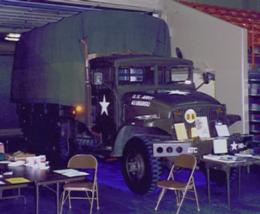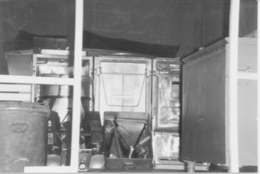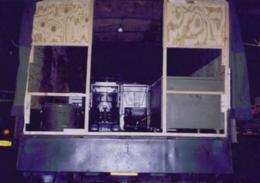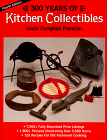
David Castle's Army Kitchen Truck
The Truck Brought Back Memories When I Saw It
By David Castle and Steve Karoly

The truck brought back lot of memories when I saw it. Although I have seen countless 2-1/2-ton trucks in my 29-year Army National Guard career, Glaiser’s M211 reminded me most of truck that I drove when I first enlisted in the Virginia Army National Guard. Since I was the lowest ranking cook in B Company of the 3rd Battalion of the 116th Infantry, I was assigned as the driver for the kitchen truck, a M211 like the one Glazier purchased. I then knew that I wanted to restore a M211 back to a kitchen truck.
Kitchen Truck in the Virginia Army National Guard
In June 1970, I did my first of seven summer camps with B Co. As the driver, my responsibilities went beyond cooking hot meals for the company. That meant: keeping the fuel tank topped off; checking the crankcase oil, brake fluid and radiator levels; making sure that all cargo – the kitchen in this case -- was properly secured; and safely driving the truck anytime the kitchen moved. And I performed preventative maintenance checks on it under the watchful eyes of my father, Sergeant First Class Dewey R. Castle, the company’s motor sergeant.
 That summer, I drove the kitchen truck in convoy from
our armory in Fairfax County, Va. to Fort Pickett, a 200-mile journey
that took about six hours. Once B Co. deployed to the field, the cooks
cooked and served two hot meals each day in the back of the truck. Our
day started at 0300 hours and did not end until late in the evening
– sometimes as late as 2200 hours. While one cook lit the fickle
M1937 fire units, the other four cooks started breakfast. The first
order of business was to brew coffee since we all know that cooks do
not function well without it. The coffee started, two cooks grilled
potatoes and eggs for breakfast on the M1937 field ranges in the truck
– space limited the number of cooks who could work in the back of
the truck – while the other two cooks prepared the coffee and hot
cereal in one of the field ranges that had been set on the ground.
That summer, I drove the kitchen truck in convoy from
our armory in Fairfax County, Va. to Fort Pickett, a 200-mile journey
that took about six hours. Once B Co. deployed to the field, the cooks
cooked and served two hot meals each day in the back of the truck. Our
day started at 0300 hours and did not end until late in the evening
– sometimes as late as 2200 hours. While one cook lit the fickle
M1937 fire units, the other four cooks started breakfast. The first
order of business was to brew coffee since we all know that cooks do
not function well without it. The coffee started, two cooks grilled
potatoes and eggs for breakfast on the M1937 field ranges in the truck
– space limited the number of cooks who could work in the back of
the truck – while the other two cooks prepared the coffee and hot
cereal in one of the field ranges that had been set on the ground.
Contrary to the advice of early editions of Army Mess Operations (TM 10-405), we did not cook in the truck while it was moving, primarily for safety due to Virginia’s hilly terrain. The 1957 edition of the technical manual advised: "[The supper meal can be prepared] while the truck is in transit to the combat area, so that the truck may move up to the combat area under cover of darkness and have the supper meal ready when it arrives at its destination." Instead, we kept the truck in a secure location and delivered hot meals to soldiers in their positions.
From the kitchen truck, which was located several miles to the rear with the company’s field train, we transported hot chow to these soldiers in M1944 insulated food containers – called Mermites by Army cooks. We fed these soldiers first. We sent one cook to each location along with one kitchen police (KP) to served the meal. After we recovered the Mermites and the cooks and KPs had eaten, we got started on the evening meal. This is also the time that we baked cakes and pastries for the next day. The dinner meal would go along about the same way.
When it came time to move the kitchen, the company commander usually gave us about 8 hours notice. Since it only took us about an hour to breakdown the truck, we normally had sufficient time to pack all of our equipment and rations. Everyone was given C-rations until we could get our kitchen set up to where we could again cook.
The Kitchen Truck
My restored M211 kitchen truck is modeled after the truck that I drove for B Co. Five cooks can prepare hot two to three meals for a company of 225 soldiers each day in the truck. When meal call rings out over the company area, each soldier walks up a set of steps to a catwalk that is fastened along the right side of the truck. As he walks along the catwalk, KPs, who are standing behind a 36-inch high serving counter, portion the meal into his mess kit. Next the soldier walks down another set of steps and walks into the company area to enjoy his meal.
 The truck’s "main battery" consists of
three M1937 field ranges that have been were secured to floor in the
truck bed just behind the cab. The M1937 served as the Army’s
primary field stove from the beginning of World War II until the end
of the Vietnam War. Each range is equipped with a gasoline-powered
fire unit, 10- and 15-gallon stockpots, a heavy aluminum roasting and
baking pan, and a set of knives and utensils. The truck is also
equipped with Mermite cans, two-and-one-half-gallon beverage jugs,
five-gallon water and gasoline cans, and a tool chest. A 220-pound ice
chest sits on the right-rear corner of the truck bed.
The truck’s "main battery" consists of
three M1937 field ranges that have been were secured to floor in the
truck bed just behind the cab. The M1937 served as the Army’s
primary field stove from the beginning of World War II until the end
of the Vietnam War. Each range is equipped with a gasoline-powered
fire unit, 10- and 15-gallon stockpots, a heavy aluminum roasting and
baking pan, and a set of knives and utensils. The truck is also
equipped with Mermite cans, two-and-one-half-gallon beverage jugs,
five-gallon water and gasoline cans, and a tool chest. A 220-pound ice
chest sits on the right-rear corner of the truck bed.
The tarpaulin cover is raised by about 24 inches so the cooks have sufficient headroom. The top of the kitchen stands 11 feet, 7 inches above ground level. The sidewalls on the driver’s and passenger’s side of the truck are not of equal height. The sidewall on the driver’s side rises up to the top of the bows to support a set of kitchen cabinets, much like a kitchen cabinet in a home. The sidewall on the passenger’s side stands 36 inches high. It supports the serving counter. The back of the kitchen is walled off and framed for a standard door. A set of steps provides access into the truck. The catwalk on the right side of the truck folds up and is secured to the side of the truck while the truck is moving.
Return to David Castle's Restored Army Kitchen Truck
February 2000
| Bulletin Board | Keyword Search |
| Bookstore | Links |
| About Us | Recent Additions |

